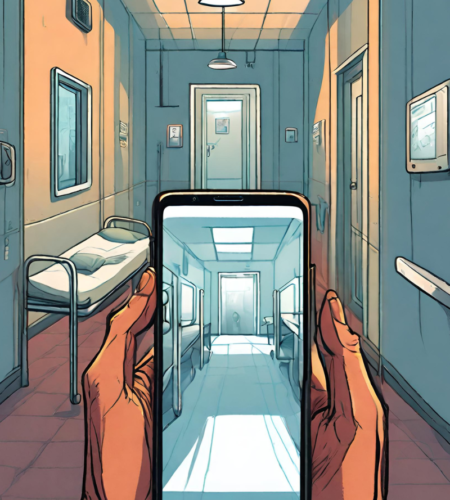The Dilemma of Cell Phone Restrictions in Therapeutic Environments
Lately, I can’t shake off this thought, especially when reflecting on my experiences in inpatient psychiatric units: Why are cell phones a no-go here? One pressing concern in the realm of mental health care, particularly in inpatient psychiatric units, is the prohibition of cell phones. This rule often sparks debate: on one hand, it’s argued that phones could distract from therapy, yet on the other, setting aside designated times for phone use seems feasible.
The Psychological Impact of Cell Phone Separation
An intriguing aspect is the psychological effect of these restrictions. Observations from child therapists reveal anxiety in young patients when separated from their phones. This phenomenon is likely not limited to children, raising questions about the potential harm caused by such policies in a setting that’s supposed to be therapeutic.
Researching the Reasons Behind the Ban
To understand the rationale behind these bans, research is key. One argument suggests that in substance abuse programs, cell phones might enable contact with enablers. However, a more patient-centered approach could be to discuss and mutually agree upon phone restrictions, rather than imposing them.
The HIPAA Hurdle and the Quest for Privacy
The issue of privacy, specifically HIPAA violations, often surfaces in discussions about cell phone bans. If privacy is the sole concern, wouldn’t a blanket ban across all hospital departments be more consistent? This selective enforcement in psychiatric units might be less about privacy and more about control or outdated policies.
Empirical Evidence Supporting Controlled Cell Phone Use
Another concern is the disruption caused by cell phones to other patients. Yet, providing designated phone-use areas could be a simple, effective compromise, maintaining peace without total restriction.
A study by Collier and Gavriel (2015) offers valuable insights. A California-based nonprofit treatment organization’s policy change to allow controlled cell phone use resulted in positive outcomes: reduced administrative burdens, no significant property or privacy issues, and improved patient communication.
The Artificial Environment Argument
The study also highlights how banning phones creates an unrealistic setting. Effective treatment should equip patients with strategies to manage their phone use post-treatment, aligning with their daily lives.
Technology in Modern Treatment Programs
Research indicates that incorporating technology into treatment is increasingly common. Thus, restricting cell phones might counteract the potential benefits of integrating technology into therapeutic processes.
Special Considerations for Involuntary Admissions
In cases of involuntary admissions, such as for suicidal patients or those involved in legal proceedings, restrictions might be necessary. However, finding a balance that respects internet access remains a challenge.
Addressing the Risk of Inappropriate Content
The potential for accessing harmful content is a valid concern. Solutions used in educational settings to limit internet access and content could be adapted for inpatient facilities, offering a balanced approach.
Reassessing the Basis for Bans
Many arguments for phone bans stem from preventive measures rather than concrete risks. This approach often neglects the patient’s well-being and may perpetuate negative stigmas around mental health and substance use.
Advocating for Patient-Centered Treatment
The principle that treatment should be voluntary and respectful of individual rights and freedoms is paramount. It’s vital to meet patients where they are, offering personalized solutions that consider their unique circumstances, rather than imposing one-size-fits-all rules.
Conclusion: Striking a Balance
While fears and concerns of healthcare professionals are understandable, a degree of compromise can address the needs of all parties. Restricting cell phones in inpatient psychiatric units needs reevaluation, focusing on solutions that respect patient autonomy and facilitate effective treatment.
Share Your Thoughts: Join the Conversation!
Let’s Discuss: Your Views on Cell Phones in Psychiatric Units
I’ve shared my perspective on the cell phone debate in psychiatric units, blending research with personal insights. Now, I’m eager to hear from you! Whether you’re a healthcare professional, a patient who has experienced these policies, or simply someone with an opinion on the topic, your voice matters.
- Do you think cell phones should be allowed in psychiatric units? Why or why not?
- Have you or someone you know been impacted by these restrictions?
- Could designated phone times be a viable solution?
- How do you balance the need for therapeutic environments with digital connectivity?
Your experiences, insights, and ideas are invaluable. By sharing, we can broaden our understanding and perhaps even influence positive changes in psychiatric care practices. Comment below, and let’s start a meaningful dialogue!
References
Collier, S., & Gavriel, M. (2015). Mobile Phones in Residential Treatment: Implications for Practice. Journal of Substance Abuse Treatment, 55, 45–51. https://doi.org/10.1016/j.jsat.2015.02.004
Morris, N. P. (2018). Internet Access for Patients on Psychiatric Units. Journal of the American Academy of Psychiatry and the Law Online, 46(2), 224–231. https://doi.org/10.29158/JAAPL.003760-18



Comments